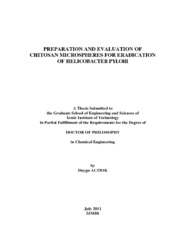Please use this identifier to cite or link to this item:
https://hdl.handle.net/11147/2891Full metadata record
| DC Field | Value | Language |
|---|---|---|
| dc.contributor.advisor | Tıhmınlıoğlu, Funda | en |
| dc.contributor.author | Altıok, Duygu | - |
| dc.date.accessioned | 2014-07-22T13:48:33Z | - |
| dc.date.available | 2014-07-22T13:48:33Z | - |
| dc.date.issued | 2011 | en |
| dc.identifier.uri | http://hdl.handle.net/11147/2891 | - |
| dc.description | Thesis (Doctoral)--Izmir Institute of Technology, Chemical Engineering, Izmir, 2011 | en |
| dc.description | Includes bibliographical references (leaves: 110-127) | en |
| dc.description | Text in English; Abstract: Turkish and English | en |
| dc.description | xiii, 149 leaves | en |
| dc.description | Full text release delayed at author's request until 2014.08.24 | - |
| dc.description.abstract | The main focus of this dissertation is to develop chitosan based microspheres loaded with antibiotic and essential oil to eradicate Helicobacter pylori by maintaining the constant drug level and prolonged gastric retention. The primary objective was to show that novel essential oil loaded microspheres are promising in the treatment of H. pylori infection as an alternative to conventional antibiotic therapy. In this context, firstly, the minimum inhibitory concentration of clarithromycin and five essential oils namely lemongrass oil, thyme oil, clove leaf oil, lemon oil and cinnamon bark oil on H. pylori was investigated. Among five essential oils, cinnamon bark oil showed the strongest anti-H. pylori activity. After choosing the most effective essential oil on H. pylori, we focused on the preparation of clarithromycin and cinnamon bark oil loaded microspheres by spray drying technique. Spray drying conditions were optimized by reponse surface methodology. Genipin, a natural crosslinker, was used as a crosslinking agent to achieve controlled drug release. Finally, it was aimed to investigate the clarithromycin and essential oil release in buffer solution and their antibacterial activity on H. pylori when released from microspheres. Higuchi equation well described the release characteristics. Drug release from microspheres was diffusion controlled. Cinnamon bark oil and clarithromycin released from the microspheres inhibited the growth of H. pylori resulting that the antibacterial activity of cinnamon bark oil and clarithromycin was maintained during the microsphere manufacturing. In conclusion, clarithromycin and cinnamon bark oil loaded chitosan microspheres have a great potential to be used as a control release system in treatment of H. pylori infection. | en |
| dc.language.iso | en | en_US |
| dc.publisher | Izmir Institute of Technology | en |
| dc.rights | info:eu-repo/semantics/openAccess | en_US |
| dc.subject.lcsh | Helicobacter pylori infections | en |
| dc.subject.lcsh | Chitosan--Biotechnology | en |
| dc.title | Preparation and evaluation of chitosan microspheres for eradication of helicobacter pylori | en_US |
| dc.type | Doctoral Thesis | en_US |
| dc.department | Thesis (Doctoral)--İzmir Institute of Technology, Chemical Engineering | en_US |
| dc.relation.publicationcategory | Tez | en_US |
| item.languageiso639-1 | en | - |
| item.fulltext | With Fulltext | - |
| item.openairecristype | http://purl.org/coar/resource_type/c_18cf | - |
| item.openairetype | Doctoral Thesis | - |
| item.grantfulltext | open | - |
| item.cerifentitytype | Publications | - |
| Appears in Collections: | Phd Degree / Doktora | |
Files in This Item:
| File | Description | Size | Format | |
|---|---|---|---|---|
| 412042.pdf | DoctoralThesis | 4.04 MB | Adobe PDF |  View/Open |
CORE Recommender
Page view(s)
33,306
checked on Jul 22, 2024
Download(s)
150
checked on Jul 22, 2024
Google ScholarTM
Check
Items in GCRIS Repository are protected by copyright, with all rights reserved, unless otherwise indicated.